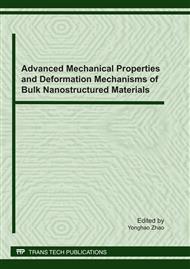p.183
p.189
p.193
p.203
p.213
p.225
p.233
p.243
p.249
Achievable Strength of Nanostructured Composites with Co-Deformable Components
Abstract:
Large amount of research has been undertaken on the effects of conventional thermomechanical treatment and chemistry variations on the mechanical properties of nanostructured bulk materials developed for wire rod and sheet products. The thermomechanical treatments are selected to refine as much as possible the microstructure to achieve high strength. In most of the cases, the alloy additions are deliberated added to be beneficial to the mechanical properties of the nanostructured materials, especially the tensile strength. In addition to refine the microstructure, both the thermomechanical treatments and chemistry variations may also alter the shape and distribution of the strengthening phases. This article describes the nanostructured composites with face-centered cubic (fcc) copper or body-centered cubic (bcc) ferrite as matrix and discusses several factors that affect the mechanical strength of such materials.
Info:
Periodical:
Pages:
243-247
Citation:
Online since:
May 2011
Authors:
Price:
Сopyright:
© 2011 Trans Tech Publications Ltd. All Rights Reserved
Share:
Citation:


